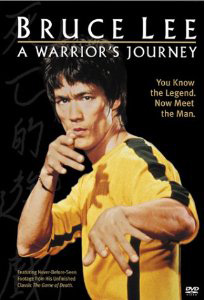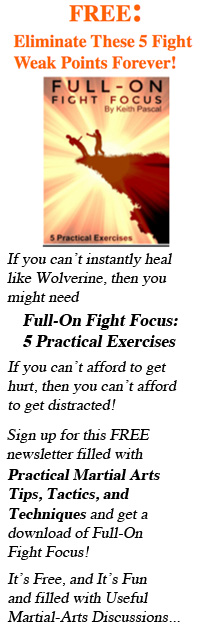Bruce Lee’s Game of Death Lesson
The Game of Death
by Keith Pascal
Have you seen any of the incarnations of Bruce Lee’s last, uncompleted film, The Game of Death?
- Note: My favorite is A Warrior’s Journey, directed by John Little.
In the movie, Bruce Lee has to fight a different martial artist from a different style, at each level of the temple, trying to make his way to the top.
Each level really does represent a different style, not like some of the movies that claim to show different systems, but they all end up looking like karate.
If You Had to Fight Bruce Lee’s Fight …
 For a minute, I want you to imagine that you are the one progressing up the floors to the top. You are going to have to fight grapplers, Filipino artists, masters of Hapkido, and so forth.
For a minute, I want you to imagine that you are the one progressing up the floors to the top. You are going to have to fight grapplers, Filipino artists, masters of Hapkido, and so forth.
Are you prepared?
There are different ways for you to approach this challenge. Which is right for you?
1. You could ignore the other person’s style and just fight in your own style, with what you know. This isn’t recommended, especially if your opponent has studied how to defeat the type of martial arts that you are exhibiting. (What you should have been doing, too.)
2. You could follow Bruce Lee’s most basic advice and avoid playing the other person’s game. In other words, don’t grapple a grappler, don’t try high kicks against a Tae Kwon Do expert, and so on. Baffle your opponent and defeat him with what you know will counter his system.
3. Most people think that Bruce Lee played the other person’s game in The Game of Death. They thought that he was stick fighting the stick artist, that he pulled out nunchaku, when the opponent did, he grappled the grappler etc. They thought that he was proving that he had mastered each style better than the masters whom he fought.
And now, the Keith Pascal take on all of this …
4. Personally, I have another theory: I think that Bruce Lee showed that he borrowed little bits from each style, and they permeated his entire repertoire of martial arts.
In other words, he fought them within each master’s style, but he used elements that were foreign to that particular system of martial arts.
His angles were tighter, he imposed his own rhythms before breaking them with interrupted timing, and took hits at unexpected spots in a known series. These little changes were devastating to his opponents … as he moved up to the top, to face Kareem Abdul Jabbar.
Did you notice in his confrontation with the above-mentioned tall dude, he had to incorporate some of what he had used on the lower levels? It was like the culmination of all of Bruce’s martial skill to be able to defeat such a tall, strong, and swift opponent … with ungodly large hands and feet.
Your Turn
The point of the above isn’t to review a movie that could have been better than Enter the Dragon, had it been completed; instead, I want to ask you a few questions?
It’s time for a little self analysis:
First, which of the above ways do you approach fighting someone from a different system? (Choose from the above four.)
If you answered “one,” then maybe you’d like to make a goal to move to number “two.”
And if you are at a “three,” I know it will take a lot of work and practice (and research), but you ought to think about moving up to a level “four.”
Next question: When you fight someone in your own style, do you use the techniques already familiar to him or her?
Hmm.
Last question: If you only had a second or two, could you discover what it will take to control the opponent in front of you, from a different style? In other words, how quick is your analysis of others?
Opinions?
Tags: a warrior's journey, bruce lee, bruce lee's last movie, fighting different styles, hapkido, john little, kareem abdul jabbar, last film, martial arts rhythm, martial arts tactics, martial-arts practice, mixing martial arts, tactics, the game of death



I remember the movie. I thought the martial arts in it were very good and even, then, Lew Al Cinder later Kareem Abdul Jabar did a great job. I also recall Kareem’s big footprint cover Lee’s entire body lol.
Yes, the fight scenes showed a thought process as to how to defeat each opponent. Making mistakes in the beginning. Mistakes that in real life could have been lethal, bu still showing a willingness to think and adapt, which was his philosophy during this era of you must punch this way
Rick
If you look at the Warrior’s Journey version … you see a bunch of dust and plaster coming down from the ceiling in one scene.
Later you find out it was Jabbar stomping with his big feet. Very cool … and very funny.
Keith
i sneaked in to see E T D at 13 years old . one of us paid in and then opened the fire exit for the rest of us,we of course got caught.
where oh where has the spirit of rebellon gone when we have never needed it so much ?
Not sure if I do any of the above. MOre likely to avoid confrontation. If forced into making a choice like the idea of borrowing little bits.
Uh … I think we are all on the same page of doing what we can to avoid confrontation. For example, it’s the main premise of the philosophy I outline in How to End the Fight with One Hit.
So, I think most of us agree with you.
And if you borrow little bits consciously, to build a more efficient system that accounts for more and more of what the bad guy might be doing to you (when you can’t just turn and get away), then I am in total agreement.
If on the other hand, your borrowed little bits are completely random, then the outcome of your fight will be … at best … completely random, too.
Keith
PS Thanks for the input.
I prefer to round out my study with a variety of different styles that focus on the different ranges and “arenas” (standing, ground, throwing, etc.) and use my dirtiest moves as they’re starting their first attack. I prefer preemptive attacks to stop it before it starts.
I kind of plug in to their energy, then just go for the knees/throat/eyes when I see that they’re distracted (or make them distracted).
The fight’s not in the style, it’s in the mind. The winner goes in ready, the loser is caught unawares.
Yes, borrow bits … this is why I write on separate topics (bits). But … you do need to know principles, otherwise those little bits won’t work. Or think of it this way: in the beginning, random bits … doing whatever you are capable of when your brain is panicking is alright.
Eventually, when fighting someone more skilled (and you are too), you’ll need to up your game … by confusing your enemy’s “game.”
Keith
I forced my parents to take me to the drive-in, to watch it
in the freezing cold of our car.
Keith